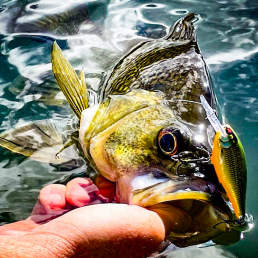Shiver Me Timbers
SHARE THIS POST
No, we’re not talking about the wooden leg of pirate Long John Silver. Rather, we’re discussing the use of subtle crankbaits in spring, cold-water conditions.
No doubt, fat-bodied, hard-wobbling crankbaits do the trick for bass in summer and early fall. Their heavy vibration alerts fish to their approach and triggers aggressive strikes when they come within striking distance.
Yet sometimes, a typically good thing can be too much of a good thing. Like when the water is cold—50 F and down—during early spring and late fall. Aggressive pulsation and retrieve speed may actually be a turnoff to lethargic bass whose metabolisms are set to low thermostat by the chilly water. But if you tone down retrieve speed, and use lures that shiver, rather than throb, both largemouths and smallmouths may respond to their subtle persuasion.
First up, we’re talking subtle shad imitators like the Rapala X-Rap, Bomber Fat-Free Shad and Berkley Bad Shad. These are extremely popular, multi-species lures, perhaps most popular with walleye anglers. But they catch all species, all year long, and are particularly effective in cold water, during cold fronts, and in the face of heavy fishing pressure. Thus, today’s big lesson is: Many subtle crankbaits used for walleyes all year long are also good for catching cold-water bass.
Often—though not exclusively—these lures are made from balsa, which makes them high-flotation when you pause your retrieve; they rise up toward the surface. Some also have what’s described as a “lively” action when aggressively fished with twitches and pauses. However, when you barely swim them along at slow speeds, with the occasional pause, their action is better described as “shivering,” or at least a reduced wobble.
Unlike rounder-bodied, “fat” wobblers, they put out far less vibration, and sort of sneak or slither through the water, rather than pulsating. Subtle is a good descriptor, which is ideal for triggering strikes in cold-water conditions. In this case, less of a good thing is a good thing in cold water. Silent baits may outproduce those with internal rattles. You’ll never know if you don’t try.
In profile, these lures resemble shad and other baitfish like perch, whereas rounder-bodied, aggressive wobblers better mimic crayfish and bluegills. Thus, they are most-often purchased and used in silvery-white or perch-patterned colors, whereas popular rounder baits often resemble some form of reddish-brown crayfish or light blue-brown-greenish bluegill patterns. All are, however, available in a rainbow of shades and combos; it’s just that anglers seldom experiment outside the range of familiar or “logical” patterns unless shown that something off-the-wall also works.
I’d be remiss if I didn’t mention my fondness for the Shad Rap RS, which is a plastic-bodied, neutrally buoyant shad imitator that suspends when paused, rather than rising like a balsa lure. It combines reduced action with deadly hovering when paused. And when moved, internal rattles produce sound that alerts fish to its presence. A better combination of features for cold water is tough to find.
Are you enjoying this post?
You can be among the first to get the latest info on where to go, what to use and how to use it!
Finally, are flat-sided crankbaits like the Bagley Flat Balsa B, Lunkerhunt Flat-Sided Squarebill and slow-rising Rapala Flat Rap (longer-bodied, hard flashing). These tend to be the province of southern bass enthusiasts who understand how effective their subtle, shivering wiggle can be in cold water.
Work these lures like shad baits: slow, subtle, simple. They tend to retain a tight action even at slower speeds, rather than beginning to wobble when slowed.
One potential advantage is that most are more snag-resistant around wood cover than shad imitators. Just keep ‘em moving fairly steadily across submerged treetops, brush, logs, and rocks, and they should climb over sticks and branches fairly clean, with minimal snags; certainly better than longer, thinner, minnow-shaped lures which flail their trebles in all directions, seemingly reaching out to try to catch wood because their thin bodies don’t protect the treble points as well as broader-bodied lures.
Since many of these lures are made from lightweight balsa, they can be tough to cast in the wind. Switching from casting to spinning gear, and using 8- to-12-pound-test mono line, makes them a lot more fishable. Heck, pretend you’re fishing for walleyes.
Once again, no disrespect to suspending minnow imitators like X-Raps or PXR Mavriks. They work wonders across weed and wood flats, and across rocky bottoms. But when it comes to bumping wood with subtle attraction, flat-sided baits are better suited for bass extraction in cold water.
The next time you’re heading out for bass in cold-water conditions, don’t forget to bring along a few “flats” and “shads” for experimental purposes. After all, it’s easy to shift your box of shad imitators from your walleye gear into the boat, just in case, to give bass the shivers.
For helpful bass fishing insight, check out the articles in every issue of MidWest Outdoors. Subscribe on our website.
MWO
SHARE THIS POST
You may also like...
Nothing found.
Did you enjoy this post?
You can be among the first to get the latest info on where to go, what to use and how to use it!
Dave Csanda
Dave Csanda has enjoyed 40 years in the fishing communications industry at In-Fisherman, Angling Edge and now, as editor of MidWest Outdoors. He is an inductee of both the Minnesota and National Fresh Water Fishing Halls of Fame.
